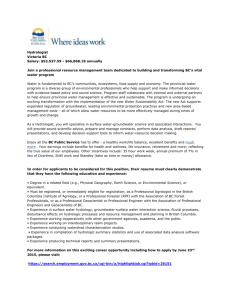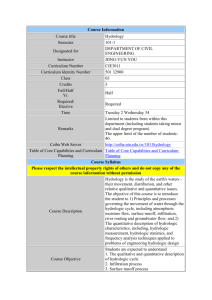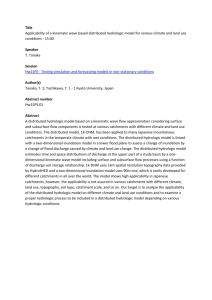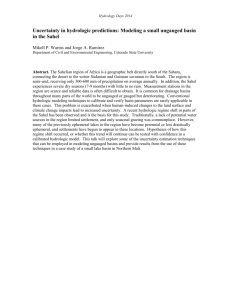The Consortium of Universities for the Advancement of Hydrologic
advertisement
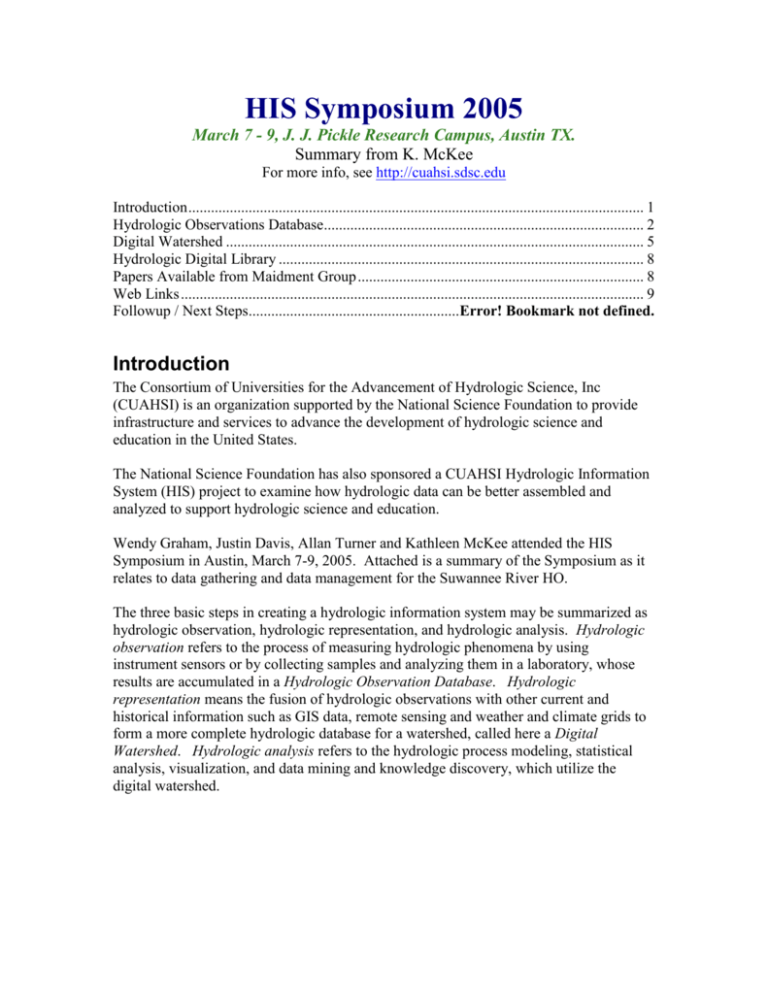
HIS Symposium 2005 March 7 - 9, J. J. Pickle Research Campus, Austin TX. Summary from K. McKee For more info, see http://cuahsi.sdsc.edu Introduction ......................................................................................................................... 1 Hydrologic Observations Database..................................................................................... 2 Digital Watershed ............................................................................................................... 5 Hydrologic Digital Library ................................................................................................. 8 Papers Available from Maidment Group ............................................................................ 8 Web Links ........................................................................................................................... 9 Followup / Next Steps........................................................Error! Bookmark not defined. Introduction The Consortium of Universities for the Advancement of Hydrologic Science, Inc (CUAHSI) is an organization supported by the National Science Foundation to provide infrastructure and services to advance the development of hydrologic science and education in the United States. The National Science Foundation has also sponsored a CUAHSI Hydrologic Information System (HIS) project to examine how hydrologic data can be better assembled and analyzed to support hydrologic science and education. Wendy Graham, Justin Davis, Allan Turner and Kathleen McKee attended the HIS Symposium in Austin, March 7-9, 2005. Attached is a summary of the Symposium as it relates to data gathering and data management for the Suwannee River HO. The three basic steps in creating a hydrologic information system may be summarized as hydrologic observation, hydrologic representation, and hydrologic analysis. Hydrologic observation refers to the process of measuring hydrologic phenomena by using instrument sensors or by collecting samples and analyzing them in a laboratory, whose results are accumulated in a Hydrologic Observation Database. Hydrologic representation means the fusion of hydrologic observations with other current and historical information such as GIS data, remote sensing and weather and climate grids to form a more complete hydrologic database for a watershed, called here a Digital Watershed. Hydrologic analysis refers to the hydrologic process modeling, statistical analysis, visualization, and data mining and knowledge discovery, which utilize the digital watershed. For the purposes of this document, we will not discuss Hydrological Analysis. Hydrologic Observations Database The hydrologic observations database is a relational database that stores streamflow, rainfall, water quality, groundwater and climate data measured at point locations and serves them through an internet interface. It serves to purpose to “get all the hydrologic data for a region in a consistent format ” rather than having to search all over the internet for data sources, spending long periods of time learning how to operate these various web sites, and synthesizing the data in many different formats that the web sites provide. This is implemented using the ESRI products ArcIMS (Internet Map Service) and ArcSDE (Spatial Database Engine). The data itself is stored in a commercial relational database (MS SQL/Server, DB2 or Oracle) that has first to be installed on the database server. Individual data users can make copies of the data into an ESRI Personal Geodatabase, which is an MS Access file. The HIS team suggests we use these web sites to get tabular hydrologic information: 1. National Climate Data Center - precipitation and air temperature 2. EPA Storet - water quality data 3. USGS National Water Information System - surface and groundwater 4. Other local sources Designing and building an integrated hydrologic observations database is a fairly formidable task. Fortunately, some operational experience has been gained using the Arc Hydro time series data format, and the strengths and weaknesses of that format have been evaluated. David Maidment was asked to design a customized version of ArcGIS for water resources, now called Arc Hydro, and he convened a GIS in Water Resources Consortium of industry, government and academics to help accomplish this task. Several national meetings were held to discuss variants on this design, and in 2002 it was published (Maidment, 2002). One of the key aspects of Arc Hydro is that it provides a means of integrate geospatial features with time series observations by uniquely labeling all the geospatial features with an identifier, their HydroID, and the labeling each time series observations associated with those features with this identifier, in much the same way as the USGS data are labeled with site number, and the EPA data with Station ID. The complete description of a set of hydrologic observations in Arc Hydro requires three tables and two relationships that are arranged within a relational database (geodatabase): the TimeSeries table containing the actual data, the MonitoringPoint table containing the location and description of the measurement sites, and a TSType table that describes the character of the time series data. The Arc Hydro time series format provides a solid foundation for storing Hydrologic Observational data in the CUAHSI Hydrologic Information System but detailed review and examination by the CUAHSI community of the format and attributes used in this structure is needed. Observational data on rainfall, streamflow, water quality and groundwater levels have been compiled for the Neuse basin into the Arc Hydro time series format, and an ArcIMS internet web service (Figure 1) has been constructed to display the measurement points and to enable downloading of the time series information in a comma delimited form as a .csv file. It is normal to think of a map service as serving and delivering maps on the internet but in this case, the map serves as a backdrop for the display and downloading of time series information on sets of observational data. Figure 1. ArcIMS Application serving hydrologic observations on the internet. Digital Watershed In addition to the Hydrologic Observations Database, the Digital Watershed also contains a significant volume of GIS data, weather and climate grids and remote sensing information. A prototype digital watershed is developed for the Neuse basin by using geospatial and temporal data collected from several sources. The Neuse digital watershed also contains data collected by Duke’s Hydrologic Observatory. The current version digital watershed is split into three separate geodatabases: NeuseSurfaceWater, NeuseGroundWater, and NeuseAtmosphericWater. NeuseSurfaceWater Within an ArcHydro framework (a feature dataset), store: streamflow stations (NWIS etc) water quality measurement points (NWIS etc) groundwater measurement points (NWIS etc) ? rainfall stations (NCDC etc) the HRAP grid (used for NEXRAD estimated precip) drainage areas hydrojunctions (subset of streamflow measurements – surface water ouflow of each catchment) reaches waterbodies (+ wetlands?) Store a Geology and Soils feature dataset geology and faults and aquifers SSURGO, STATSGO Store rasters: DEM (based on LIDAR) LULC (from EPA) flow accumulation grid (derived from NeuseDEM using ArcHydro terrain processing) flow direction grid (derived from NeuseDEM using ArcHydro terrain processing) EVI (veg index) – MODIS rasters Store Time series hydrologic Data: Water quality streamflow precipitation NeuseGroundWater Store the hydrogeology of the aquifer system The Aquifer feature class describes the boundary of aquifers within the study area, and water quality zones (salty, transition, fresh) within the aquifer. The data was obtained from the Center for the Analysis and Prediction of River Basin Environmental Systems (http://www.env.duke.edu/cares/neuse/GIS.html) Wells – o Stratigraphy were created from a the USGS GMS model (GMS Groundwater Modeling System - groundwater modeling environment for MODFLOW) o Monitoring wells were obtained from the North Carolina Division of Water Resources 3D Borelines which represent stratigraphy at boreholes (from USGS model) – View using ArcScene BoreLines representing hydrostratigraphy Geovolumes represent solid models which describe the hydrogeology of the subsurface - interpolated as part of the MODFLOW model by the USGS and extracted from the GMS files into the geodatabase GeoVolumes of the Surficial and Yorktown hydrogeologic formations GeoArea feature class describes geologic formations and recharge and discharge areas. The spatial extent of the formations is stored in the GeoArea feature class and additional details are stored in the GeologicFormations table. Geologic formations in the Neuse River Basin Recharge / Discharge zones Water areas and water lines represent the stream network and the waterbodies on the surface (1:100,000) Store Time Series data: water elevations for the Surficial aquifer (feet above mean sea level) in the monitoring wells from the North Carolina Division of Water Resources website (what happened to NWIS?) Store Raster Series in a Raster Catalog: interpolated water elevation rasters NeuseAtmosphericWater Store Hydroclimatology feature datasets has 2 feature classes: MonitoringPoint feature class marking the location of atmospheric observation stations (NCDC) NARRPoint feature class is the grid points for the North American Regional Reanalysis (NARR) model developed and maintained by the National Centers for Environmental Prediction (NCEP). Although NARR is a continental scale model (32-km grid cells), the output provides information on the energy and water fluxes important for closing the water and energy budgets. Each NARRPoint feature is related to a collection of time series (one for each variable). NARR data is available on 3hr and monthly averaged time steps. Store a RasterSeries in a raster catalog contains NEXRAD rasters obtained from the NCDC. It can also be used to store rasters generated from interpolation of the NARR points or the NCDC rainfall gages. Each raster within the raster catalog is indexed by a time (TSDateTime) and a time series type (TSType). Hydrologic Digital Library A Hydrologic Digital Library is a repository of digital files from all three components of the Hydrologic Information System, which describes the files with metadata to enable them to be stored permanently, and identified and retrieved through web-based searches and automated data acquisition systems The Hydrologic Digital Library is a repository of digital files of any character (called Arbitrary Digital Objects or ADOs) that are indexed by a metadata catalog which operates in the PostgreSQL relational database. This system is currently implemented in Linux. (This would be the Access Database we have now with 2 added things: a user interface to search, and a data retrieval system). They are developing a Papers Available from Maidment Group A Data Model for Hydrologic Observations Hydrologic Flux, Flow and Storage HIS_USA: A prototype digital watershed for USA Digital Watershed for the Neuse Basin Web Links 1. CUAHSI HIS Page: http://www.iihr.uiowa.edu/~cuahsi/his/ 2. HIS prototype: Neuse River - at the San Diego Super Computer Center: http://cuahsi001.sdsc.edu/html/index.html 3. ArcHydro Data Model: http://support.esri.com/index.cfm?fa=downloads.dataModels.filteredGateway&d mid=15 4. National Hydrography Dataset: http://nhdgeo.usgs.gov/viewer.htm 5. USGS NWISWeb: http://waterdata.usgs.gov/nwis 6. NCDC data: http://www.ncdc.noaa.gov/oa/climate/stationlocator.html 7. EPA Storet Water quality data: http://www.epa.gov/storet/dbtop.html




